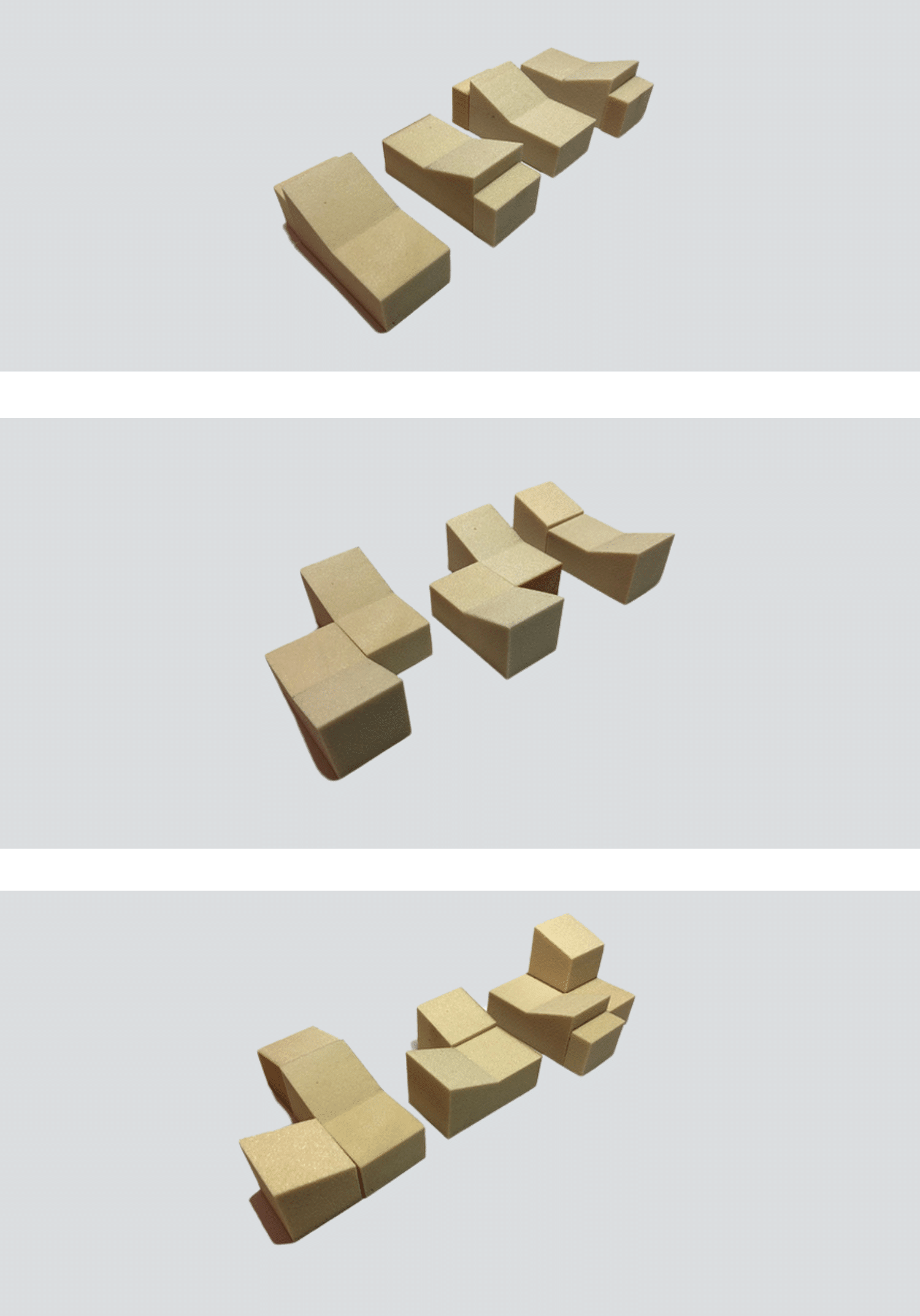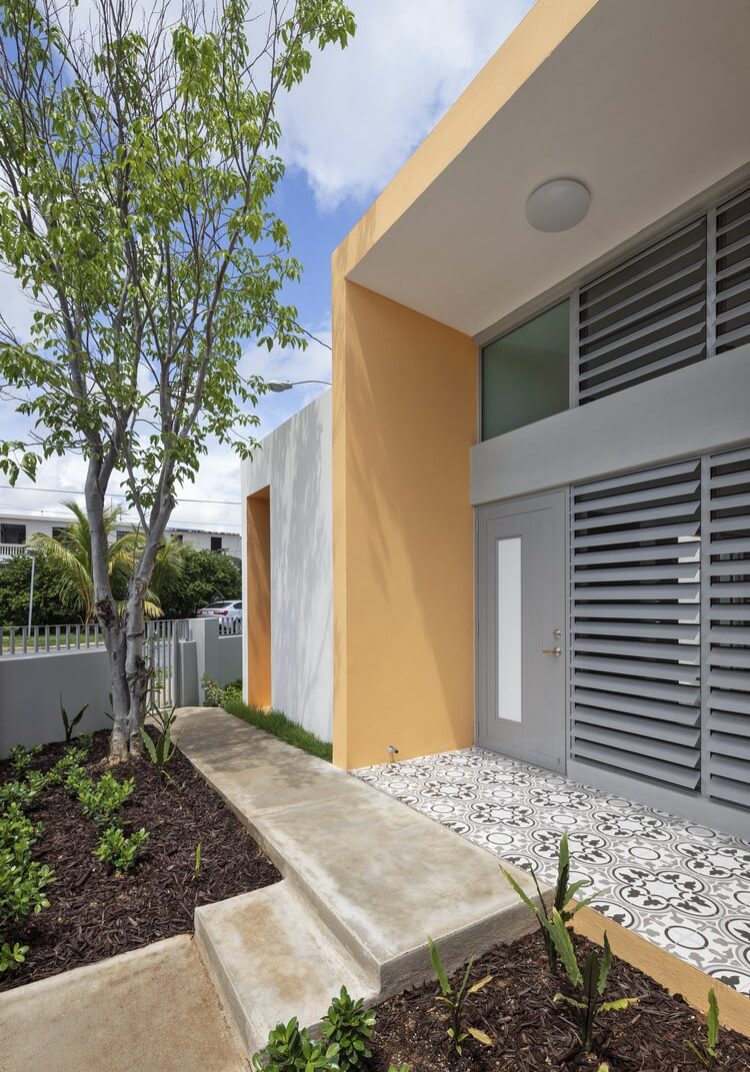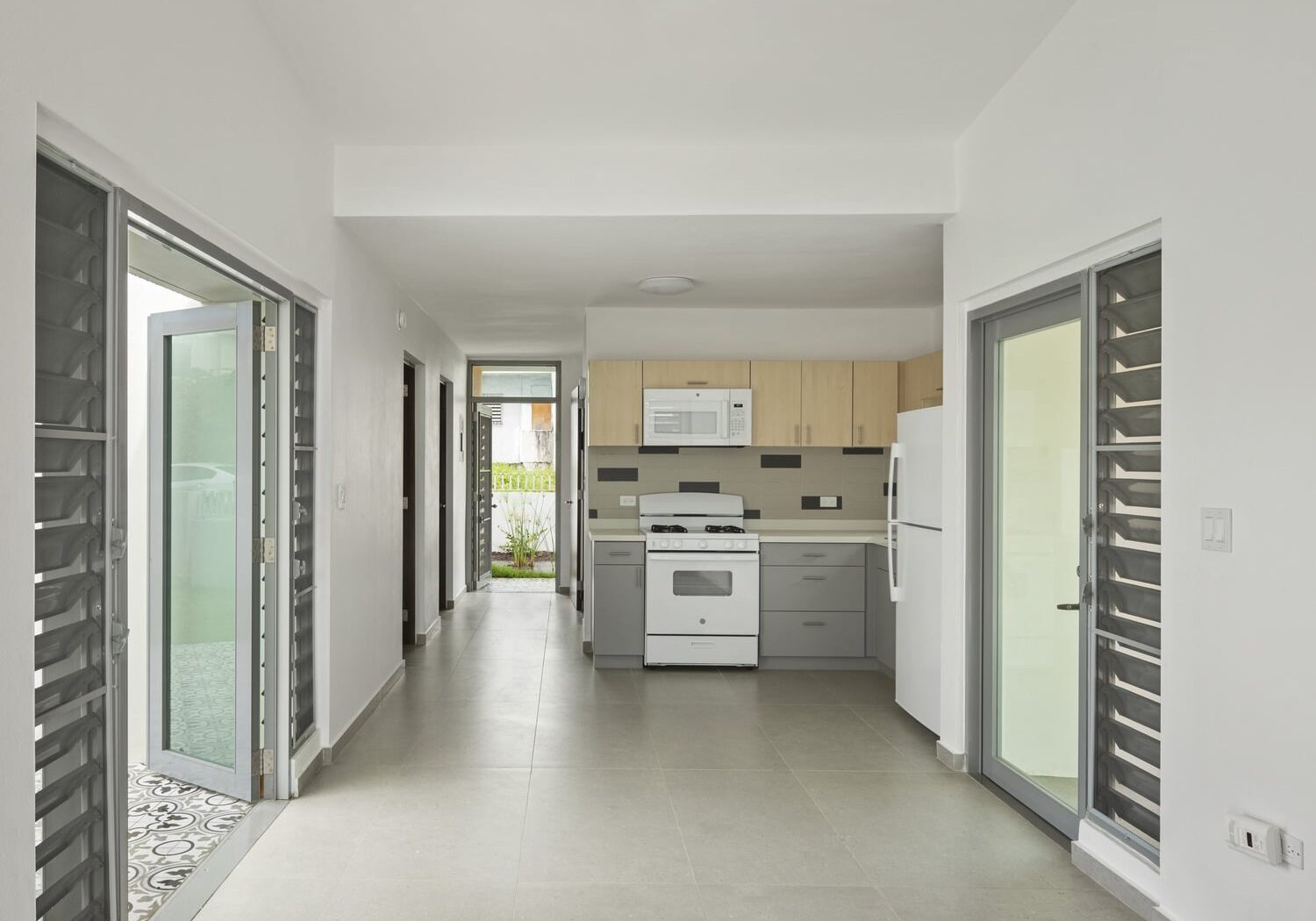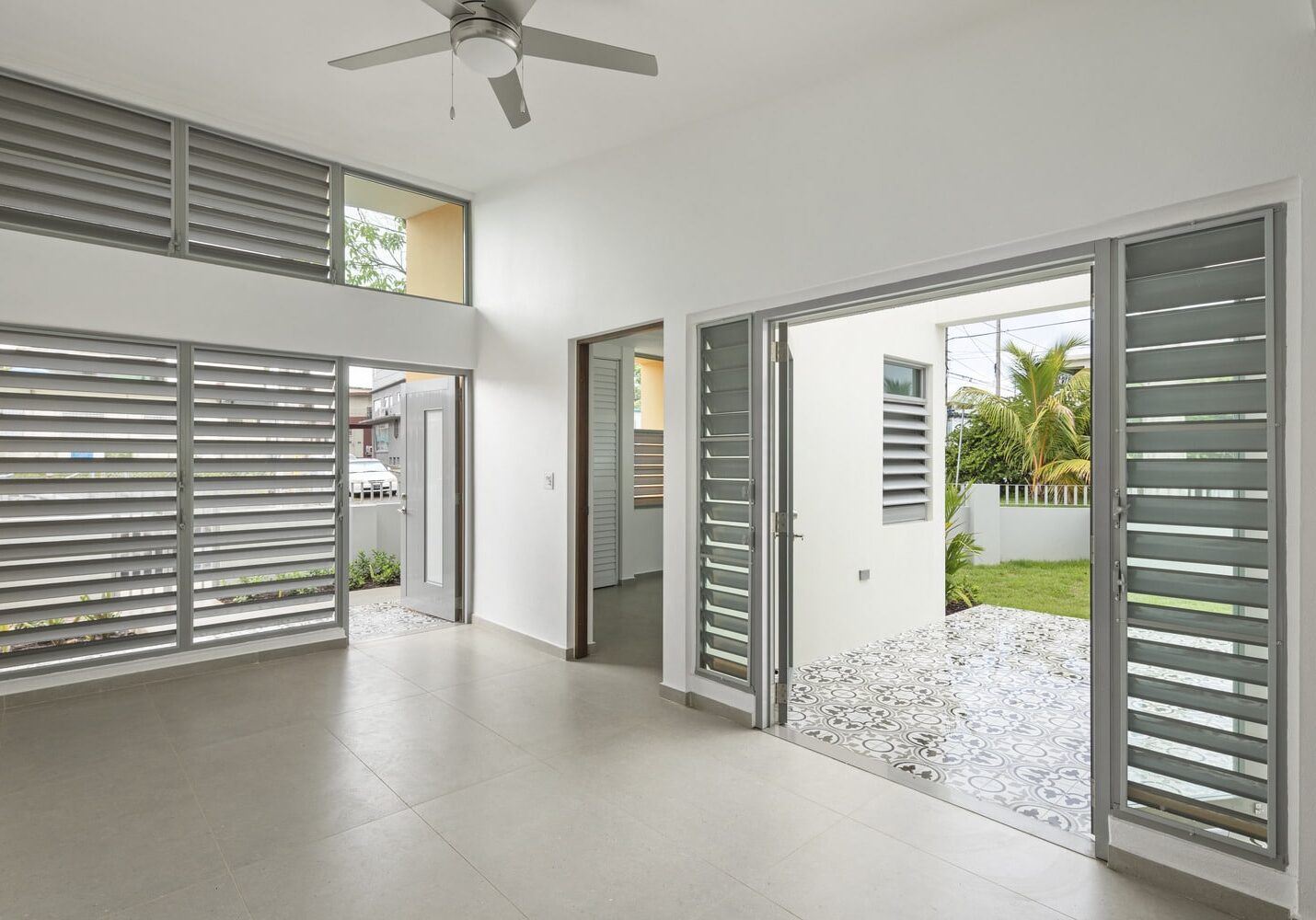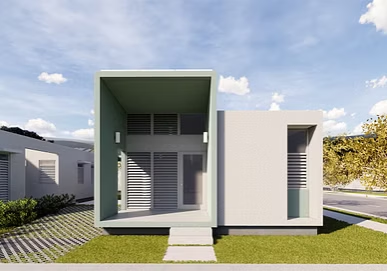Acacia Resilient Homes Prototype
A model for future housing in vulnerable regions.
The Acacia Resilient Homes prototype offers a sustainable and affordable housing solution tailored to Puerto Rico's unique climate and culture. Developed in response to the devastation caused by Hurricane Maria in 2017, the design focuses on resilience, utilizing features like natural lighting, ventilation, and rainwater capture gardens. The prototype aims for low energy consumption through passive design strategies and renewable energy sources, targeting long-term sustainability and cost-effectiveness. Modular in nature, the design allows for easy expansion and adaptability, supplemented by a self-supporting infrastructure that includes renewable energy and water harvesting systems. A comprehensive user manual ensures residents can effectively utilize the home's resilient features.
"As on the rest of the island, the electric grid went down, and it wasn’t clear how many homes had been damaged or destroyed. But in two new prototype homes, the electricity stayed on."
Adele Peters, Fast Company "These prototype homes didn’t lose power when Hurricane Fiona slammed Puerto Rico. Here’s why"
Through an iterative process, the team developed building blocks tailored to Puerto Rico’s unique climate and culture. What emerged was an agile kit of parts—one that can be adapted to different scenarios while still providing resilience, sustainability and affordability for its users.
This innovative prototype not only offers hope for those affected by natural disasters but also serves as an example of how collaboration with local communities can help build better futures in vulnerable regions worldwide.
Passive design strategies provide natural cross ventilation, heat extraction and shade.
Durable finishes and materials have been used to ensure that the homes are able to withstand extreme weather conditions for many years.
To reduce energy consumption and environmental impact, the homes are designed with public utilities supplemented by a self-supporting infrastructure powered by renewable energy sources. Two main distribution panels provide electricity, one optimized for heavy loads and another for lighter ones.
A model for future housing in vulnerable regions.
The Acacia Resilient Homes prototype offers a sustainable and affordable housing solution tailored to Puerto Rico's unique climate and culture. Developed in response to the devastation caused by Hurricane Maria in 2017, the design focuses on resilience, utilizing features like natural lighting, ventilation, and rainwater capture gardens. The prototype aims for low energy consumption through passive design strategies and renewable energy sources, targeting long-term sustainability and cost-effectiveness. Modular in nature, the design allows for easy expansion and adaptability, supplemented by a self-supporting infrastructure that includes renewable energy and water harvesting systems. A comprehensive user manual ensures residents can effectively utilize the home's resilient features.
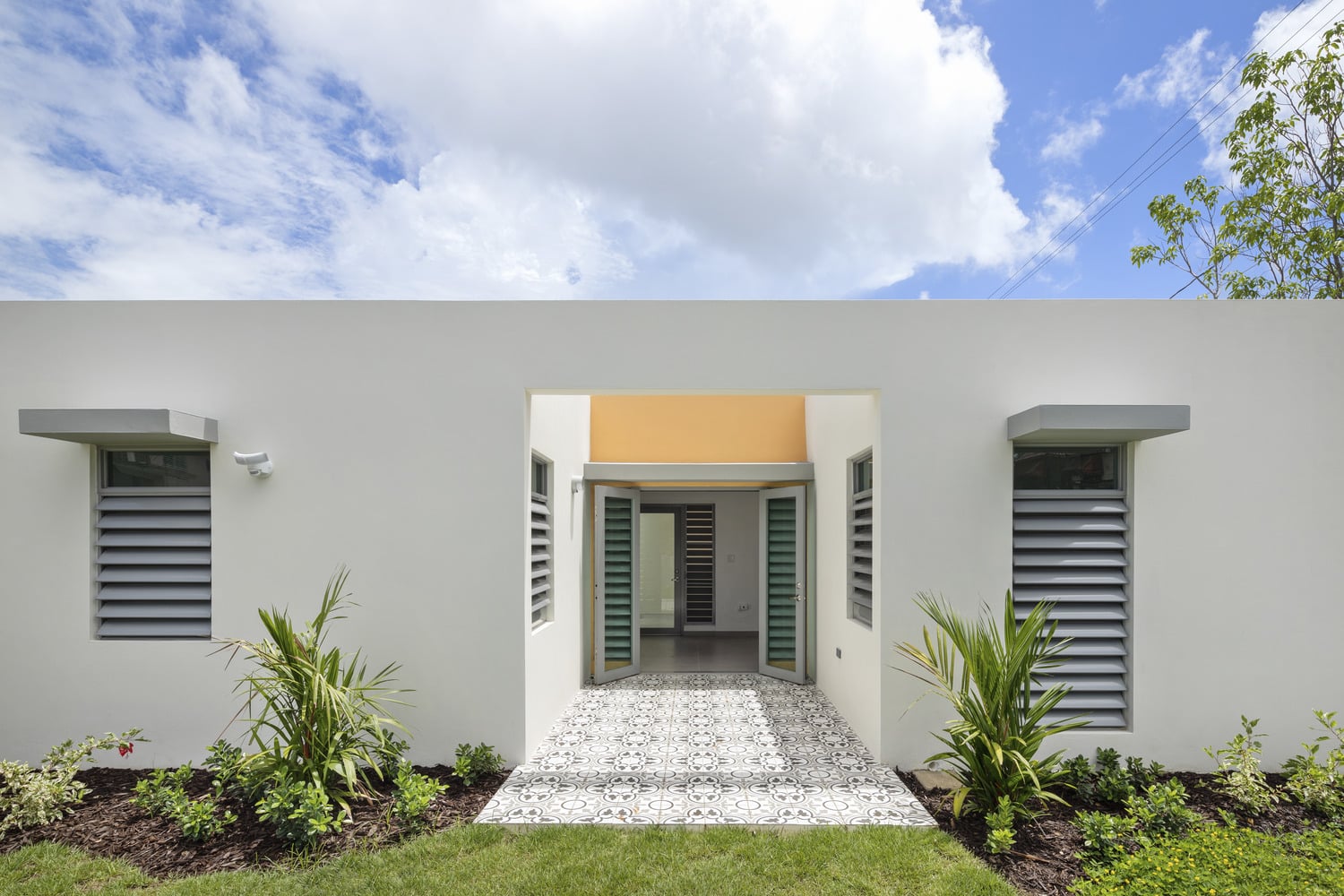
The passive design strategies included the use of a courtyard as a way to provide a protected exterior area within the homes footprint, as well as a tool to integrate exterior illumination and spaces to the residential interior.

"As on the rest of the island, the electric grid went down, and it wasn’t clear how many homes had been damaged or destroyed. But in two new prototype homes, the electricity stayed on."
Adele Peters, Fast Company "These prototype homes didn’t lose power when Hurricane Fiona slammed Puerto Rico. Here’s why"
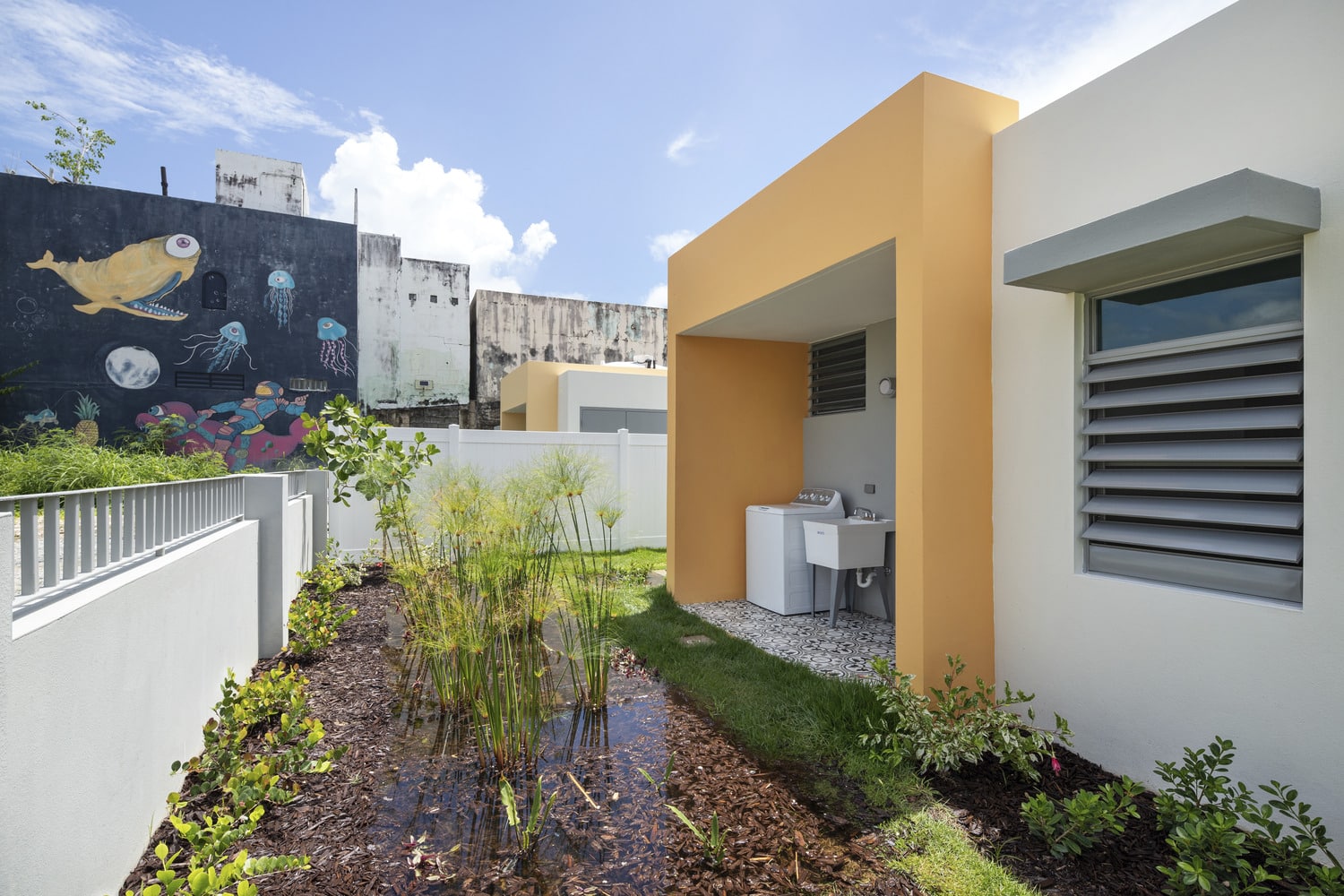
The rear and lateral yards have been designed with rainwater gardens intended as a sustainable storm water management component, helping to reduce flooding due to water runoff.
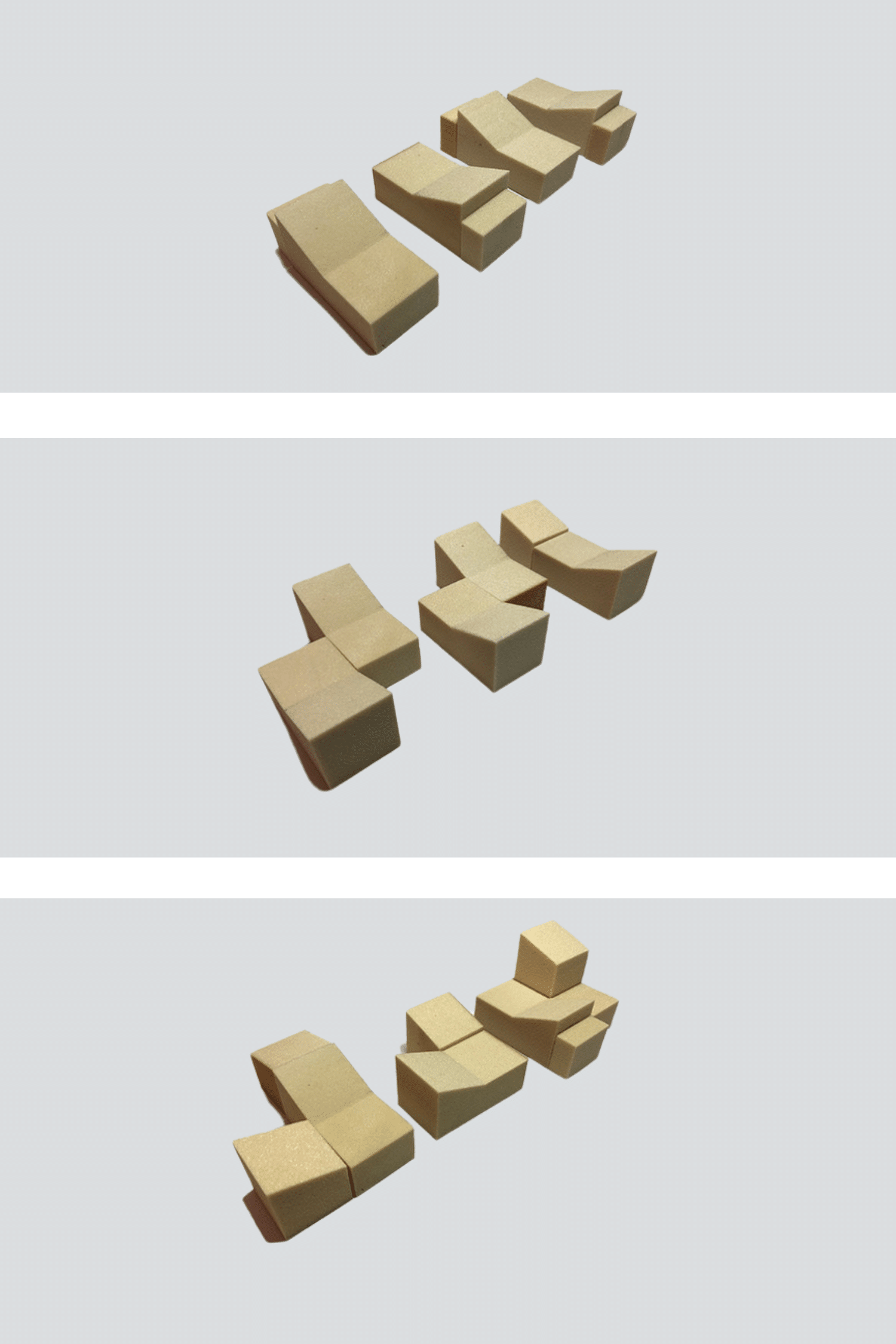
Through an iterative process, the team developed building blocks tailored to Puerto Rico’s unique climate and culture. What emerged was an agile kit of parts—one that can be adapted to different scenarios while still providing resilience, sustainability and affordability for its users.

This innovative prototype not only offers hope for those affected by natural disasters but also serves as an example of how collaboration with local communities can help build better futures in vulnerable regions worldwide.

As a prototype, the design is not site-specific. With four points of access, this design is just one iteration that provides adaptability for different site scenarios, allowing for access through the main façade, or at either of the long side elevations.


Passive design strategies provide natural cross ventilation, heat extraction and shade.

Durable finishes and materials have been used to ensure that the homes are able to withstand extreme weather conditions for many years.
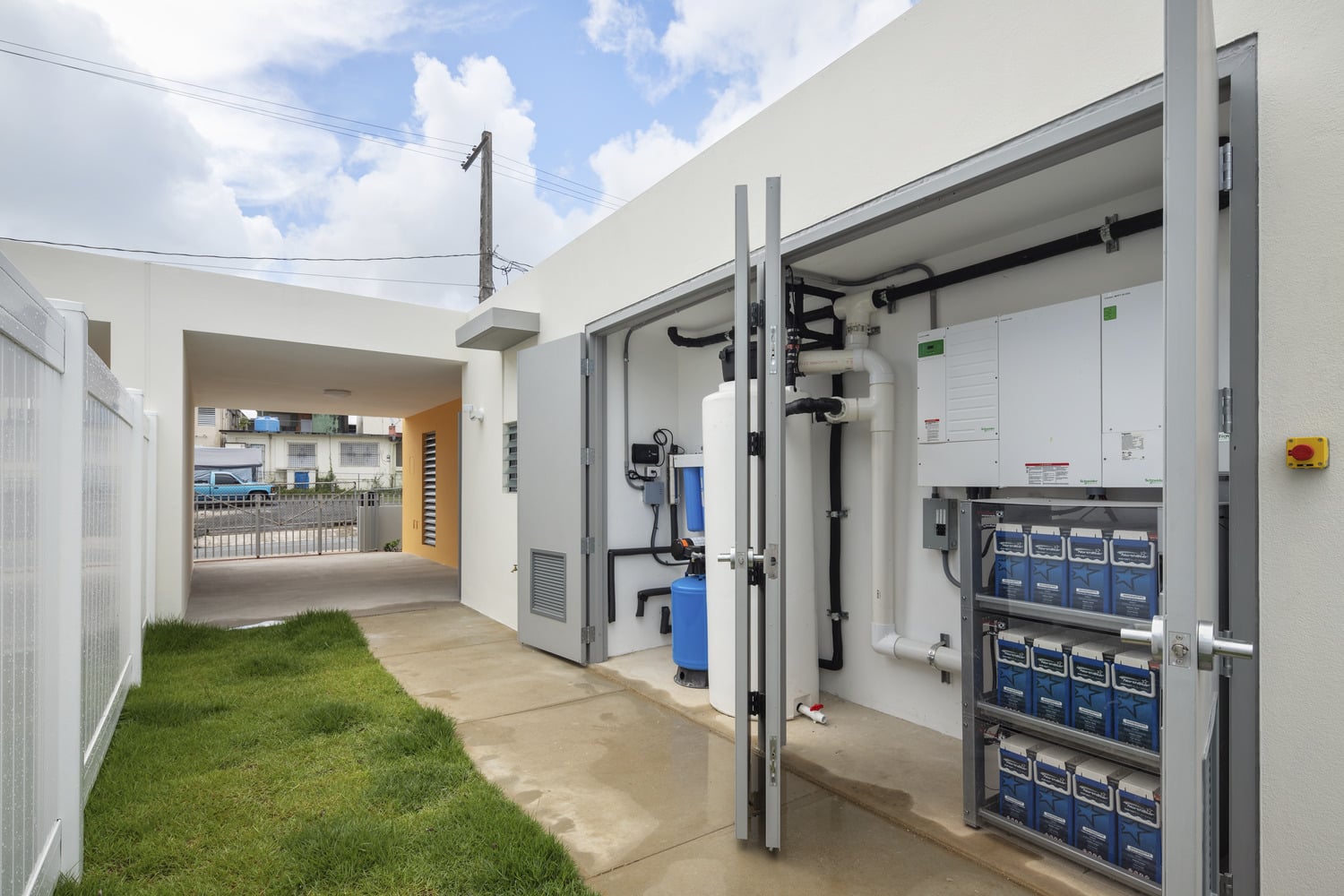
To reduce energy consumption and environmental impact, the homes are designed with public utilities supplemented by a self-supporting infrastructure powered by renewable energy sources. Two main distribution panels provide electricity, one optimized for heavy loads and another for lighter ones.
Acacia Resilient Homes Prototype
A model for future housing in vulnerable regions.
The Acacia Resilient Homes prototype offers a sustainable and affordable housing solution tailored to Puerto Rico's unique climate and culture. Developed in response to the devastation caused by Hurricane Maria in 2017, the design focuses on resilience, utilizing features like natural lighting, ventilation, and rainwater capture gardens. The prototype aims for low energy consumption through passive design strategies and renewable energy sources, targeting long-term sustainability and cost-effectiveness. Modular in nature, the design allows for easy expansion and adaptability, supplemented by a self-supporting infrastructure that includes renewable energy and water harvesting systems. A comprehensive user manual ensures residents can effectively utilize the home's resilient features.
"As on the rest of the island, the electric grid went down, and it wasn’t clear how many homes had been damaged or destroyed. But in two new prototype homes, the electricity stayed on."
Adele Peters, Fast Company "These prototype homes didn’t lose power when Hurricane Fiona slammed Puerto Rico. Here’s why"
Through an iterative process, the team developed building blocks tailored to Puerto Rico’s unique climate and culture. What emerged was an agile kit of parts—one that can be adapted to different scenarios while still providing resilience, sustainability and affordability for its users.
This innovative prototype not only offers hope for those affected by natural disasters but also serves as an example of how collaboration with local communities can help build better futures in vulnerable regions worldwide.
Passive design strategies provide natural cross ventilation, heat extraction and shade.
Durable finishes and materials have been used to ensure that the homes are able to withstand extreme weather conditions for many years.
To reduce energy consumption and environmental impact, the homes are designed with public utilities supplemented by a self-supporting infrastructure powered by renewable energy sources. Two main distribution panels provide electricity, one optimized for heavy loads and another for lighter ones.
A model for future housing in vulnerable regions.
The Acacia Resilient Homes prototype offers a sustainable and affordable housing solution tailored to Puerto Rico's unique climate and culture. Developed in response to the devastation caused by Hurricane Maria in 2017, the design focuses on resilience, utilizing features like natural lighting, ventilation, and rainwater capture gardens. The prototype aims for low energy consumption through passive design strategies and renewable energy sources, targeting long-term sustainability and cost-effectiveness. Modular in nature, the design allows for easy expansion and adaptability, supplemented by a self-supporting infrastructure that includes renewable energy and water harvesting systems. A comprehensive user manual ensures residents can effectively utilize the home's resilient features.

The passive design strategies included the use of a courtyard as a way to provide a protected exterior area within the homes footprint, as well as a tool to integrate exterior illumination and spaces to the residential interior.

"As on the rest of the island, the electric grid went down, and it wasn’t clear how many homes had been damaged or destroyed. But in two new prototype homes, the electricity stayed on."
Adele Peters, Fast Company "These prototype homes didn’t lose power when Hurricane Fiona slammed Puerto Rico. Here’s why"

The rear and lateral yards have been designed with rainwater gardens intended as a sustainable storm water management component, helping to reduce flooding due to water runoff.

Through an iterative process, the team developed building blocks tailored to Puerto Rico’s unique climate and culture. What emerged was an agile kit of parts—one that can be adapted to different scenarios while still providing resilience, sustainability and affordability for its users.

This innovative prototype not only offers hope for those affected by natural disasters but also serves as an example of how collaboration with local communities can help build better futures in vulnerable regions worldwide.

As a prototype, the design is not site-specific. With four points of access, this design is just one iteration that provides adaptability for different site scenarios, allowing for access through the main façade, or at either of the long side elevations.


Passive design strategies provide natural cross ventilation, heat extraction and shade.

Durable finishes and materials have been used to ensure that the homes are able to withstand extreme weather conditions for many years.

To reduce energy consumption and environmental impact, the homes are designed with public utilities supplemented by a self-supporting infrastructure powered by renewable energy sources. Two main distribution panels provide electricity, one optimized for heavy loads and another for lighter ones.
Acacia Resilient Homes Prototype
A model for future housing in vulnerable regions.
The Acacia Resilient Homes prototype offers a sustainable and affordable housing solution tailored to Puerto Rico's unique climate and culture. Developed in response to the devastation caused by Hurricane Maria in 2017, the design focuses on resilience, utilizing features like natural lighting, ventilation, and rainwater capture gardens. The prototype aims for low energy consumption through passive design strategies and renewable energy sources, targeting long-term sustainability and cost-effectiveness. Modular in nature, the design allows for easy expansion and adaptability, supplemented by a self-supporting infrastructure that includes renewable energy and water harvesting systems. A comprehensive user manual ensures residents can effectively utilize the home's resilient features.
"As on the rest of the island, the electric grid went down, and it wasn’t clear how many homes had been damaged or destroyed. But in two new prototype homes, the electricity stayed on."
Adele Peters, Fast Company "These prototype homes didn’t lose power when Hurricane Fiona slammed Puerto Rico. Here’s why"
Through an iterative process, the team developed building blocks tailored to Puerto Rico’s unique climate and culture. What emerged was an agile kit of parts—one that can be adapted to different scenarios while still providing resilience, sustainability and affordability for its users.
This innovative prototype not only offers hope for those affected by natural disasters but also serves as an example of how collaboration with local communities can help build better futures in vulnerable regions worldwide.
Passive design strategies provide natural cross ventilation, heat extraction and shade.
Durable finishes and materials have been used to ensure that the homes are able to withstand extreme weather conditions for many years.
To reduce energy consumption and environmental impact, the homes are designed with public utilities supplemented by a self-supporting infrastructure powered by renewable energy sources. Two main distribution panels provide electricity, one optimized for heavy loads and another for lighter ones.
A model for future housing in vulnerable regions.
The Acacia Resilient Homes prototype offers a sustainable and affordable housing solution tailored to Puerto Rico's unique climate and culture. Developed in response to the devastation caused by Hurricane Maria in 2017, the design focuses on resilience, utilizing features like natural lighting, ventilation, and rainwater capture gardens. The prototype aims for low energy consumption through passive design strategies and renewable energy sources, targeting long-term sustainability and cost-effectiveness. Modular in nature, the design allows for easy expansion and adaptability, supplemented by a self-supporting infrastructure that includes renewable energy and water harvesting systems. A comprehensive user manual ensures residents can effectively utilize the home's resilient features.

The passive design strategies included the use of a courtyard as a way to provide a protected exterior area within the homes footprint, as well as a tool to integrate exterior illumination and spaces to the residential interior.

"As on the rest of the island, the electric grid went down, and it wasn’t clear how many homes had been damaged or destroyed. But in two new prototype homes, the electricity stayed on."
Adele Peters, Fast Company "These prototype homes didn’t lose power when Hurricane Fiona slammed Puerto Rico. Here’s why"

The rear and lateral yards have been designed with rainwater gardens intended as a sustainable storm water management component, helping to reduce flooding due to water runoff.

Through an iterative process, the team developed building blocks tailored to Puerto Rico’s unique climate and culture. What emerged was an agile kit of parts—one that can be adapted to different scenarios while still providing resilience, sustainability and affordability for its users.

This innovative prototype not only offers hope for those affected by natural disasters but also serves as an example of how collaboration with local communities can help build better futures in vulnerable regions worldwide.

As a prototype, the design is not site-specific. With four points of access, this design is just one iteration that provides adaptability for different site scenarios, allowing for access through the main façade, or at either of the long side elevations.


Passive design strategies provide natural cross ventilation, heat extraction and shade.

Durable finishes and materials have been used to ensure that the homes are able to withstand extreme weather conditions for many years.


